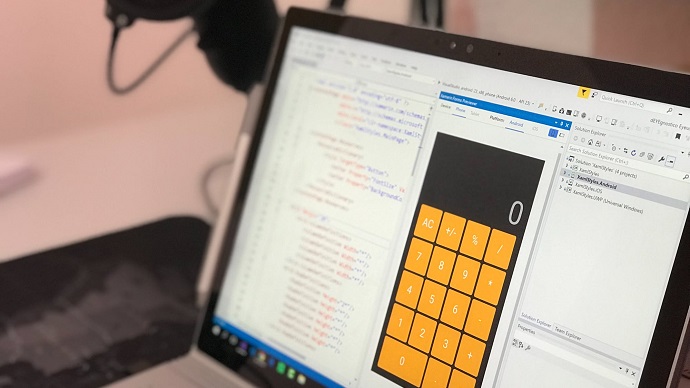
300-420: Designing Cisco Enterprise Networks (ENSLD)
PDFs and exam guides are not so efficient, right? Prepare for your Cisco examination with our training course. The 300-420 course contains a complete batch of videos that will provide you with profound and thorough knowledge related to Cisco certification exam. Pass the Cisco 300-420 test with flying colors.

Curriculum for 300-420 Certification Video Course
| Name of Video | Time |
|---|---|
 1. SCALABLE EIGRP DESIGNS AND FAST CONVERGENCE |
11:00 |
 2. Examine EIGRP Autonomous Systems and Layered Designs |
7:00 |
 3. EIGRP HUB&SPOKE AND STUB DESIGNS |
7:00 |
 4. Describe EIGRP Convergence Features |
5:00 |
| Name of Video | Time |
|---|---|
 1. Designing OSPF Routing |
4:00 |
 2. OSPF Neighbor Adjacencies and LSA's |
5:00 |
 3. OSPF Scalability Issues |
7:00 |
 4. Define Area and Domain Summarization |
5:00 |
 5. OSPF Full and Partial Mesh |
8:00 |
 6. OSPF Convergence |
12:00 |
| Name of Video | Time |
|---|---|
 1. Designing IS-IS Routing |
4:00 |
 2. Describe the IS-IS Routing Protocol |
11:00 |
 3. Examine IS-IS Adjacencies and Authentication |
7:00 |
 4. IS-IS and OSPF Similarities |
16:00 |
 5. Explore IS-IS Routing Logic |
12:00 |
 6. Describe IS-IS Operations |
20:00 |
 7. Examine Integrated IS-IS for IPv6 |
8:00 |
| Name of Video | Time |
|---|---|
 1. Designing BGP Routing |
4:00 |
 2. IBGP Scalability, Route Reflectors and Split Horizon |
9:00 |
 3. BGP Route Reflector Terminology |
9:00 |
 4. Describe BGP Split Horizon |
4:00 |
 5. Route Reflector Loop Prevention Mechanisms |
6:00 |
 6. Compare BGP Load Sharing Designs |
8:00 |
 7. BGP Load Sharing |
15:00 |
| Name of Video | Time |
|---|---|
 1. BGP Address Families and Attributes |
4:00 |
 2. BGP ADDRESS FAMILY MODEL |
10:00 |
 3. BGP Route Selection |
17:00 |
 4. Describe BGP Communities |
14:00 |
 5. Designing a Dual-Stack MP-BGP Environment |
8:00 |
| Name of Video | Time |
|---|---|
 1. Designing Enterprise Campus |
4:00 |
 2. End to End vs Local VLAN’s |
11:00 |
 3. Layer 3 Access Layer |
3:00 |
 4. Common Access-Distribution Interconnection Designs |
4:00 |
| Name of Video | Time |
|---|---|
 1. Designing Layer 2 Campus |
4:00 |
 2. VLAN’s , Trunks, VTP and STP |
6:00 |
 3. Understanding the Spanning Tree Protocol |
12:00 |
 4. Understand MST, POE, and EnergyWise |
17:00 |
 5. Ether Channel |
11:00 |
 6. First Hop Redundancy |
11:00 |
 7. Describe Network Requirements of Applications |
10:00 |
| Name of Video | Time |
|---|---|
 1. Designing Layer 3 Campus |
5:00 |
 2. The Benefits of Building Triangles |
3:00 |
 3. Routing Convergence |
4:00 |
 4. Routing Protocols and Summarization |
5:00 |
 5. Default Routes, Redistribution and Filtering |
8:00 |
 6. Passive Interfaces Convergence and IPv4 |
11:00 |
 7. Describe Network Management Best Practices |
8:00 |
| Name of Video | Time |
|---|---|
 1. Discovering SD Access Architecture |
4:00 |
 2. Overview of SD Access Part 1 |
16:00 |
 3. Overview of SD Access Part 2 |
12:00 |
 4. SD Access Node Roles |
14:00 |
 5. Examine the Fabric Enabled Wireless LAN |
5:00 |
 6. Describe the Role of Cisco SD-Access in Cisco DNA |
9:00 |
| Name of Video | Time |
|---|---|
 1. SD Access Fabric Constructs |
14:00 |
 2. Design Requirements of Underlay Network |
6:00 |
 3. DHCP and Security Solutions for the Fabric Domain |
8:00 |
 4. Describe Sizing and Single Platform Scalability |
16:00 |
| Name of Video | Time |
|---|---|
 1. Discovering Service Provider Managed VPN's |
4:00 |
 2. WAN Connection Decision Points |
4:00 |
 3. Layer 3 MPLS |
4:00 |
 4. Use Routing Protocols at the PE-CE |
15:00 |
| Name of Video | Time |
|---|---|
 1. Enterprise Managed VPN Overview |
3:00 |
 2. Describe GRE, mGRE, and IPsec |
18:00 |
 3. Describe Dynamic VTI, GET VPN, SSL |
19:00 |
 4. Describe DMVPN |
18:00 |
 5. EIGRP DMVPN and DMVPN Scaling |
6:00 |
| Name of Video | Time |
|---|---|
 1. WAN Design Overview |
1:00 |
 2. Common MPLS Design Models |
2:00 |
 3. Describe Common Layer 2 WAN Design Models |
2:00 |
 4. Describe Common VPN WAN Design Models |
4:00 |
 5. Describe Cellular VPN Design Models |
1:00 |
 6. Remote Site Local Internet Connectivity |
2:00 |
 7. Remote Site LAN Design |
5:00 |
 8. Case Studies |
7:00 |
 9. Describe Basic Traffic Engineering Techniques |
4:00 |
Cisco ENSLD 300-420 Exam Dumps, Practice Test Questions
100% Latest & Updated Cisco ENSLD 300-420 Practice Test Questions, Exam Dumps & Verified Answers!
30 Days Free Updates, Instant Download!
300-420 Premium Bundle

- Premium File: 386 Questions & Answers. Last update: Dec 27, 2025
- Training Course: 75 Video Lectures
- Study Guide: 812 Pages
- Latest Questions
- 100% Accurate Answers
- Fast Exam Updates
Cisco 300-420 Training Course
Want verified and proven knowledge for Designing Cisco Enterprise Networks (ENSLD)? Believe it's easy when you have ExamSnap's Designing Cisco Enterprise Networks (ENSLD) certification video training course by your side which along with our Cisco 300-420 Exam Dumps & Practice Test questions provide a complete solution to pass your exam Read More.
Cisco 300-420 Training for Enterprise Wireless Network Professionals
Cisco CCNP Enterprise (300-420) ENSLD Practice Exam: Ideal for Independent Study and Self-Evaluation
Course Overview
The Cisco 300-420 ENWLSI training course is a comprehensive program designed for IT professionals and network engineers seeking to enhance their knowledge and skills in wireless LAN solutions. This course provides a deep understanding of wireless network design, deployment, troubleshooting, and optimization while aligning with the ENWLSI exam objectives. It is structured to offer a combination of theoretical knowledge and practical hands-on experience, ensuring participants can confidently implement enterprise-grade wireless networks. The course emphasizes real-world application, giving learners the opportunity to apply concepts in simulated environments that mimic complex network scenarios.
By enrolling in this course, participants will gain insights into designing scalable and secure wireless LAN infrastructures, configuring and managing Cisco access points and controllers, and performing site surveys to optimize coverage and performance. The curriculum also covers advanced topics such as wireless security protocols, threat mitigation strategies, and performance monitoring tools, equipping students with the expertise necessary to handle diverse network challenges. Furthermore, the course is structured to support exam preparation for the Cisco 300-420 ENWLSI certification, integrating practice questions, case studies, and strategies to ensure participants are well-prepared for the certification process.
Throughout the course, learners will develop a strong foundation in network engineering concepts related to wireless technologies, which can significantly enhance their career opportunities and credibility in the IT industry. By the end of the program, participants will not only be prepared for the certification exam but also capable of implementing and managing wireless LAN solutions in real-world enterprise environments.
What You Will Learn from This Course
Understanding the fundamentals of wireless LAN solutions, including architecture, components, and operational principles
Analyzing and interpreting RF spectrum characteristics to design efficient wireless networks
Configuring and managing Cisco access points and wireless controllers for enterprise environments
Planning and conducting site surveys to ensure optimal coverage and performance
Implementing scalable and secure wireless LAN designs that meet business requirements
Applying wireless security protocols and authentication methods to safeguard networks
Identifying and troubleshooting common wireless network issues and performance bottlenecks
Utilizing monitoring and optimization tools to maintain network reliability and efficiency
Preparing effectively for the Cisco 300-420 ENWLSI certification with exam-focused strategies and practice questions
Developing practical skills through hands-on labs and real-world scenario simulations
Learning Objectives
Upon completion of the Cisco 300-420 ENWLSI training course, participants will be able to:
Describe wireless LAN architecture and key components, including access points, controllers, and antennas
Apply RF fundamentals to design networks that minimize interference and maximize coverage
Configure Cisco wireless devices for optimal performance in enterprise environments
Plan and implement wireless LAN solutions tailored to organizational needs
Conduct detailed site surveys and analyze results to inform network design decisions
Implement advanced wireless security measures, including encryption, authentication, and threat mitigation
Diagnose and resolve wireless network issues using industry-standard tools and techniques
Monitor and optimize network performance to maintain service quality and reliability
Demonstrate readiness for the Cisco 300-420 ENWLSI certification exam through targeted practice and application of learned concepts
Integrate theoretical knowledge with practical experience to manage wireless LAN solutions effectively
Requirements
To successfully participate in this course, learners should have a foundational understanding of networking concepts and basic familiarity with enterprise network environments. While the course is designed to accommodate varying skill levels, the following requirements will help participants maximize their learning experience:
Basic knowledge of networking principles, including TCP/IP, routing, and switching
Familiarity with Cisco devices and operating systems
Understanding of network protocols and services commonly used in enterprise environments
Access to a computer or virtual lab environment for hands-on practice
Commitment to completing course modules, assignments, and lab exercises
Having prior experience in network administration or engineering can be beneficial, but it is not strictly necessary. The course is structured to gradually build knowledge from foundational wireless concepts to advanced topics, allowing participants to develop practical skills even if their prior experience is limited.
Course Description
This Cisco 300-420 ENWLSI training course offers an in-depth exploration of wireless LAN solutions and their application in enterprise networks. The program covers a wide range of topics, including wireless architecture, RF principles, site surveys, security protocols, and performance optimization. Participants will learn to design, implement, and troubleshoot wireless networks using Cisco technologies, gaining both theoretical understanding and practical experience through lab exercises and real-world simulations.
The curriculum emphasizes the importance of designing scalable and secure networks capable of meeting business demands. Learners will explore advanced topics such as interference mitigation, authentication mechanisms, encryption standards, and monitoring tools to ensure network reliability and performance. By integrating exam-focused preparation throughout the course, participants will also gain the knowledge and confidence required to pass the Cisco 300-420 ENWLSI certification exam.
Throughout the program, learners will engage in hands-on labs that simulate complex wireless network scenarios, providing practical experience in configuring access points, controllers, and associated network components. The course also includes detailed explanations of troubleshooting methodologies, allowing participants to identify and resolve common issues that arise in enterprise wireless environments.
By the end of the course, participants will possess the skills necessary to design, deploy, and manage wireless LAN solutions effectively while being fully prepared for certification and real-world application.
Target Audience
This training course is designed for a diverse group of IT professionals and network engineers who wish to specialize in wireless LAN solutions and prepare for the Cisco 300-420 ENWLSI certification. The target audience includes:
Network engineers seeking to enhance their expertise in wireless technologies
IT professionals responsible for designing, implementing, and maintaining enterprise wireless networks
Individuals preparing for the Cisco 300-420 ENWLSI certification exam
System administrators who want to expand their knowledge of wireless network design and deployment
Professionals interested in learning best practices for wireless security and performance optimization
Technical consultants who advise organizations on wireless network solutions
This course is suitable for both individuals with prior networking experience and those looking to gain specialized skills in wireless LAN solutions. The program is structured to support participants at various skill levels while providing advanced topics and hands-on practice for experienced professionals.
Prerequisites
While the Cisco 300-420 ENWLSI training course is designed to build knowledge from the ground up, certain prerequisites are recommended to ensure participants can fully benefit from the program:
A fundamental understanding of networking concepts, including routing, switching, and IP addressing
Familiarity with Cisco devices and enterprise network environments
Basic knowledge of network protocols, services, and security concepts
Experience with network troubleshooting and configuration tools is beneficial but not required
Access to lab environments for hands-on practice to reinforce theoretical knowledge
Having these prerequisites will allow participants to focus on advanced topics related to wireless LAN solutions, including RF design, site surveys, security implementation, and performance optimization. Learners without prior experience will still gain valuable skills, but those with foundational knowledge will be able to progress more quickly through the course material and maximize the benefits of hands-on labs.
Course Modules/Sections
The Cisco 300-420 ENWLSI training course is organized into multiple modules to provide a structured approach for mastering wireless LAN solutions. Each module builds upon the previous one, starting from fundamental concepts and advancing to complex scenarios in network design, deployment, and troubleshooting. The modular structure allows participants to absorb concepts gradually while applying them through practical exercises and hands-on labs.
The first module introduces wireless LAN fundamentals, including architecture, components, and RF principles. This section ensures participants understand the basic building blocks of wireless networks, including access points, controllers, antennas, and their interaction with enterprise network infrastructure. Detailed explanations of RF spectrum analysis and signal propagation help learners anticipate and mitigate interference issues.
The second module focuses on wireless network design. Participants learn how to plan scalable, high-performance networks that meet business requirements. Topics include site surveys, coverage analysis, and capacity planning. This module emphasizes the importance of aligning network design with organizational goals, taking into account factors such as user density, device types, and traffic patterns.
The third module covers wireless security. Participants explore authentication methods, encryption protocols, and advanced threat mitigation strategies. Real-world examples illustrate common security challenges and how to address them effectively. The module also covers regulatory compliance considerations and best practices for protecting sensitive data in wireless environments.
The fourth module is dedicated to troubleshooting and performance optimization. Learners examine common issues in wireless LANs, including connectivity problems, interference, and performance bottlenecks. Participants gain experience using monitoring and diagnostic tools to identify problems, implement corrective actions, and maintain optimal network performance.
The final module integrates all previous concepts into practical applications. Participants engage in scenario-based exercises that simulate real-world challenges, reinforcing knowledge and building confidence in wireless network design and management. Exam-focused sessions provide targeted practice questions, case studies, and strategies to prepare for the Cisco 300-420 ENWLSI certification.
Key Topics Covered
The Cisco 300-420 ENWLSI training course addresses a wide range of topics relevant to wireless LAN solutions and enterprise network design. Key areas of focus include:
Wireless LAN architecture and components, including access points, controllers, and antennas
RF fundamentals, spectrum analysis, and interference management
Network design principles for enterprise WLAN solutions, including scalability and high-density environments
Site survey techniques, coverage planning, and capacity analysis
Wireless security protocols, authentication methods, and encryption standards
Threat detection, mitigation strategies, and best practices for securing wireless networks
Performance optimization techniques, including troubleshooting common issues, identifying bottlenecks, and applying corrective measures
Monitoring tools and methodologies for maintaining network health and reliability
Integration of wireless LAN solutions with existing enterprise network infrastructure
Practical applications through lab exercises, scenario simulations, and hands-on practice
The course also emphasizes real-world case studies, allowing learners to analyze complex network environments, identify potential challenges, and apply learned solutions. Participants gain experience in designing and deploying networks that meet both technical and business requirements, providing a well-rounded understanding of wireless LAN implementation.
Additional topics include managing high-density deployments, ensuring quality of service for wireless applications, and adapting networks to support emerging technologies. Participants learn to evaluate network performance using metrics and analytical tools, enabling proactive optimization and effective troubleshooting. The curriculum is continuously updated to reflect current trends, technologies, and industry standards, ensuring learners acquire relevant and up-to-date skills.
Teaching Methodology
The Cisco 300-420 ENWLSI course employs a blended teaching methodology designed to cater to different learning styles while providing both theoretical and practical expertise. The approach combines instructor-led sessions, interactive discussions, hands-on labs, simulations, and collaborative exercises.
Instructor-led sessions provide structured guidance on complex concepts such as wireless architecture, RF principles, and network security. Expert instructors share industry insights and practical tips, bridging the gap between theory and real-world application. These sessions are supplemented with interactive discussions, allowing participants to ask questions, share experiences, and deepen their understanding of critical topics.
Hands-on labs form a core component of the teaching methodology. Participants engage in practical exercises that simulate enterprise wireless network environments. Labs cover configuration of access points and controllers, site survey analysis, troubleshooting connectivity issues, and implementing security measures. These exercises allow learners to apply theoretical knowledge, develop problem-solving skills, and gain confidence in managing wireless LAN solutions.
Simulations are used to recreate real-world scenarios, presenting participants with challenges such as high-density deployments, interference issues, and security threats. Learners practice identifying problems, analyzing data, and applying solutions in a controlled environment, which prepares them for real network management responsibilities.
Collaborative exercises and group projects encourage teamwork and knowledge sharing. Participants work together to design networks, analyze performance metrics, and solve complex problems. This methodology fosters a deeper understanding of wireless LAN concepts while promoting communication, critical thinking, and professional collaboration skills.
The course also integrates continuous assessment through quizzes, practical exercises, and scenario-based challenges. These assessments provide immediate feedback, allowing learners to identify areas for improvement and consolidate their understanding. Exam-focused sessions include practice questions and mock tests designed to simulate the Cisco 300-420 ENWLSI certification experience, ensuring participants are prepared both theoretically and practically.
Supplementary resources, such as video tutorials, reference guides, and access to virtual labs, support self-paced learning. Participants can revisit concepts, practice configurations, and reinforce knowledge outside of structured sessions, enhancing retention and skill development. This multi-faceted teaching methodology ensures that learners not only gain knowledge but also develop the practical skills necessary for successful wireless LAN implementation and exam preparation.
Assessment & Evaluation
Assessment and evaluation are integral components of the Cisco 300-420 ENWLSI training course. They provide both participants and instructors with a clear understanding of learning progress, mastery of key concepts, and readiness for the certification exam.
The course incorporates a combination of formative and summative assessments to ensure continuous evaluation of skills and knowledge. Formative assessments include quizzes, practical exercises, and scenario-based challenges that allow learners to apply concepts in real-time. These assessments provide immediate feedback, highlighting strengths and identifying areas that require further attention. Participants can use this feedback to adjust their learning strategies and reinforce understanding.
Summative assessments are conducted at the end of each module and include comprehensive evaluations of theoretical knowledge and practical application. Written tests, lab exercises, and scenario simulations assess participants’ ability to design, configure, and troubleshoot wireless LAN solutions. These assessments measure understanding of core topics such as RF fundamentals, network design, security protocols, and performance optimization.
Hands-on evaluation is a critical component of the course. Participants complete lab exercises that mimic real-world enterprise network challenges, such as configuring access points, implementing security measures, performing site surveys, and optimizing network performance. Instructors assess accuracy, efficiency, and problem-solving approaches, ensuring learners are capable of applying knowledge in professional settings.
Scenario-based assessments simulate complex network environments, testing learners’ ability to analyze issues, make informed decisions, and implement effective solutions. These exercises reinforce critical thinking and practical skills, preparing participants for real-world wireless LAN management.
Exam preparation is embedded within the assessment process. Practice questions, mock exams, and case study analyses are used to familiarize participants with the format, scope, and complexity of the Cisco 300-420 ENWLSI certification exam. Instructors provide guidance on answering questions effectively, time management, and prioritizing topics based on individual strengths and weaknesses.
Participants’ performance is continuously monitored throughout the course. Instructors provide detailed feedback, highlighting progress, areas for improvement, and recommended learning strategies. This personalized evaluation ensures that learners remain on track to achieve mastery of wireless LAN concepts and practical skills.
The combination of theoretical assessment, practical evaluation, scenario-based exercises, and exam-focused practice ensures a holistic learning experience. By the end of the course, participants will have demonstrated competence in designing, deploying, securing, and optimizing wireless networks, while also being fully prepared for the Cisco 300-420 ENWLSI certification exam.
Benefits of the Course
The Cisco 300-420 ENWLSI training course provides numerous benefits for IT professionals, network engineers, and individuals seeking to advance their careers in enterprise wireless LAN solutions. One of the primary advantages is the comprehensive understanding of wireless network design, deployment, and management. Participants acquire practical skills that can be directly applied in real-world enterprise environments, making them highly competent in handling wireless LAN solutions effectively.
Another key benefit is certification readiness. By aligning course content with the Cisco 300-420 ENWLSI exam objectives, learners gain targeted knowledge and hands-on experience that prepare them for success in the certification process. Practice questions, scenario-based exercises, and exam-focused sessions ensure participants are familiar with the format and complexity of the exam, reducing anxiety and increasing confidence.
The course also enhances career prospects. Certified professionals in wireless LAN solutions are highly sought after by organizations looking to implement scalable and secure networks. By completing the training, participants demonstrate their expertise in wireless network design, RF fundamentals, security implementation, and troubleshooting, which can lead to promotions, higher salaries, and broader professional opportunities.
Hands-on labs and practical exercises provide experiential learning that reinforces theoretical knowledge. Participants learn how to configure access points, controllers, and other network devices, conduct site surveys, optimize performance, and troubleshoot issues. This practical experience ensures learners are capable of handling the challenges of real-world network environments and applying best practices to maintain high-performing networks.
The course also emphasizes adaptability to emerging technologies and trends. Participants gain an understanding of advanced wireless solutions, high-density deployments, and quality of service considerations. This knowledge equips learners to design networks that can accommodate future growth and evolving business needs, making them valuable assets to their organizations.
Another benefit is the development of problem-solving and analytical skills. Through scenario-based exercises and troubleshooting modules, participants learn to identify issues, analyze data, and implement effective solutions. This critical thinking capability is essential for network engineers managing complex enterprise networks.
Collaboration and knowledge-sharing opportunities within the course further enhance learning. Participants engage in group exercises and discussions, gaining insights from peers and instructors. This collaborative environment fosters professional growth, encourages networking, and helps learners develop teamwork and communication skills essential in corporate settings.
Lastly, the course promotes long-term professional development. By understanding industry standards, best practices, and emerging technologies, participants are positioned to stay competitive in the ever-evolving field of network engineering. The knowledge and skills acquired provide a foundation for further specialization, certifications, and leadership roles in wireless LAN solutions.
Course Duration
The Cisco 300-420 ENWLSI training course is designed to provide a comprehensive learning experience while allowing flexibility for participants with varying schedules and experience levels. The typical duration ranges from six to eight weeks, depending on whether the learner follows a full-time or part-time study plan. This timeframe ensures that participants can absorb complex topics thoroughly, complete hands-on labs, and engage in scenario-based exercises.
Each week of the course is structured to cover specific modules, including wireless LAN fundamentals, network design, security, troubleshooting, and practical application. Participants can expect a combination of instructor-led sessions, interactive discussions, lab exercises, and self-paced study materials. The modular approach allows learners to focus on one area at a time, reinforcing understanding before progressing to more advanced concepts.
Hands-on labs are a critical component of the course duration. Participants spend several hours per week configuring network devices, conducting site surveys, optimizing performance, and troubleshooting common issues. These exercises are designed to simulate real-world enterprise environments, providing practical experience that complements theoretical learning.
Flexible scheduling options are available to accommodate professional commitments. Online sessions, recorded lectures, and virtual labs allow participants to study at their own pace while ensuring they complete the required modules within the standard course duration. This flexibility makes it possible for working professionals to gain certification without interrupting their careers.
Exam-focused preparation is integrated throughout the course duration. Learners are encouraged to complete practice questions, mock exams, and case study analyses regularly to reinforce knowledge and track progress. Periodic assessments ensure participants are on track to achieve mastery of wireless LAN concepts and are ready for the Cisco 300-420 ENWLSI certification exam by the end of the program.
The course duration also allows time for revision, reflection, and consolidation of knowledge. Participants can revisit challenging topics, engage in additional lab exercises, and discuss questions with instructors or peers. This structured yet flexible timeline ensures comprehensive understanding and practical proficiency in wireless LAN solutions.
Overall, the duration of the Cisco 300-420 ENWLSI course balances depth of learning with practical application, ensuring participants gain both theoretical knowledge and hands-on experience required to implement, manage, and optimize enterprise wireless networks effectively.
Tools & Resources Required
Successful completion of the Cisco 300-420 ENWLSI training course requires access to specific tools and resources that support learning, hands-on practice, and exam preparation. These tools provide a practical environment in which participants can apply theoretical knowledge and develop the skills necessary for real-world wireless network implementation.
Virtual lab environments are essential tools for the course. These labs allow participants to simulate enterprise wireless network scenarios, configure access points, controllers, and associated devices, and test network performance. Virtual labs provide a risk-free environment for learners to experiment, troubleshoot, and apply best practices without impacting live systems. They are accessible online, enabling participants to complete exercises at their own pace and revisit configurations as needed.
Cisco Packet Tracer and other network simulation software are valuable resources for understanding network topology, traffic flow, and device interactions. These tools help participants visualize network design concepts, perform troubleshooting exercises, and analyze performance metrics. Simulation software complements hands-on lab exercises by providing additional practice opportunities and reinforcing theoretical learning.
Documentation and reference materials are critical resources for the course. Cisco whitepapers, configuration guides, best practice manuals, and technical documentation provide detailed information on device configuration, network design principles, security protocols, and performance optimization techniques. These resources support learning, offer guidance for lab exercises, and serve as ongoing references for real-world network management.
Access to Cisco devices, including access points, controllers, and networking hardware, enhances practical learning. While virtual labs provide simulated environments, direct interaction with physical devices allows participants to experience real-world configuration, troubleshooting, and deployment challenges. This hands-on experience is invaluable for developing proficiency in wireless LAN solutions.
Learning management systems (LMS) and online platforms provide structured access to course content, video tutorials, practice questions, and assessments. These platforms allow participants to track progress, review modules, and engage in interactive exercises. They also support collaboration through discussion forums, group activities, and instructor feedback.
Additional resources, such as RF spectrum analysis tools, network monitoring software, and troubleshooting utilities, are recommended for participants aiming to deepen their practical expertise. These tools allow learners to measure signal strength, detect interference, optimize performance, and maintain network reliability.
Exam preparation resources, including practice tests, mock exams, and scenario-based questions, are integral to the tools and resources required. These materials simulate the Cisco 300-420 ENWLSI exam experience, helping participants familiarize themselves with the format, question types, and time management strategies. Regular use of these resources enhances confidence and readiness for certification.
Finally, collaboration and peer support serve as invaluable resources throughout the course. Discussion groups, study partners, and instructor-led Q&A sessions provide opportunities to clarify concepts, share best practices, and gain insights from real-world experiences. Engaging with peers and instructors reinforces learning and encourages the practical application of knowledge in enterprise network environments.
By utilizing these tools and resources, participants can maximize their learning outcomes, gain hands-on experience, and develop the expertise required to design, implement, secure, and optimize enterprise wireless LAN solutions while preparing for the Cisco 300-420 ENWLSI certification.
Career Opportunities
Completing the Cisco 300-420 ENWLSI training course opens numerous career paths in network engineering and enterprise wireless solutions. Some of the most common opportunities include:
Network Engineer specializing in wireless LAN solutions for enterprise environments
Wireless Network Designer responsible for planning and implementing scalable wireless networks
Network Administrator managing access points, controllers, and overall WLAN performance
IT Consultant providing expert advice on wireless network design, security, and optimization
Wireless Security Specialist focusing on encryption, authentication, and threat mitigation
Infrastructure Engineer integrating wireless LAN solutions with enterprise network architecture
Technical Support Engineer troubleshooting connectivity and performance issues in WLANs
Project Manager overseeing the deployment of large-scale wireless network projects
Cloud and Wireless Solutions Architect designing advanced enterprise network infrastructures
Certification Trainer or Instructor delivering Cisco 300-420 ENWLSI-related training and workshops
These roles leverage the skills and knowledge gained through hands-on labs, scenario-based learning, and theoretical understanding. Organizations value professionals who can design secure, reliable, and high-performance wireless networks while also being prepared for certification exams.
Enroll Today
Take the next step in advancing your IT career by enrolling in the Cisco 300-420 ENWLSI training course. This program provides the knowledge, practical experience, and exam preparation needed to succeed in enterprise wireless LAN solutions and network engineering roles.
By enrolling today, you gain access to structured modules covering wireless LAN fundamentals, network design, security, troubleshooting, and hands-on labs. You will develop the expertise required to configure, manage, and optimize Cisco wireless networks while preparing for the ENWLSI certification.
The course offers flexible learning options, allowing you to study at your own pace through online sessions, virtual labs, and interactive resources. Expert instructors provide guidance, answer questions, and share real-world insights to ensure you are fully prepared for professional challenges and certification success.
Investing in this course not only equips you with technical skills but also enhances your career prospects, positioning you for advanced roles in network engineering and enterprise wireless solutions. Enroll today to begin mastering wireless LAN solutions, gain hands-on experience, and achieve the Cisco 300-420 ENWLSI certification.
Prepared by Top Experts, the top IT Trainers ensure that when it comes to your IT exam prep and you can count on ExamSnap Designing Cisco Enterprise Networks (ENSLD) certification video training course that goes in line with the corresponding Cisco 300-420 exam dumps, study guide, and practice test questions & answers.
Purchase Individually




Cisco Training Courses




















Only Registered Members can View Training Courses
Please fill out your email address below in order to view Training Courses. Registration is Free and Easy, You Simply need to provide an email address.
- Trusted by 1.2M IT Certification Candidates Every Month
- Hundreds Hours of Videos
- Instant download After Registration






